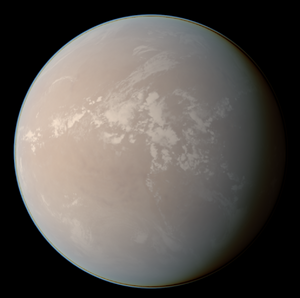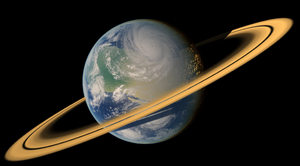Dremar System
| Age | 3.78 billion years |
|---|---|
| Location |
6.51 ly from Polytinaris Polytinaris Spur, Far 3 kpc arm |
| Nearest star |
Prunau (2.97 ly) Tainelle (5.05 ly) |
| Nearest known planetary system | Tainelle System (5.05 ly) |
| Planetary system | |
| Semi-major axis of outer known planet | 5.58 AU (Ranbov) |
Populations | |
| Known stars | 1 (Dremar) |
| Known planets | 7 (3 terrestrial planets, 4 gas giants) |
| Star-related properties | |
| Spectral type | K0.5V |
| Variable type | none |
The Dremar System is a solitary star system located 6.51 light years from the Polytinaris System, within the Milky Way's Far 3 kpc arm. The system is the home system of the Kenario Imperio and its two member species: the quadrupedal Kenarions and the pig-like Sanquans. Additionally, it was also conquered and annexed by the Tessian Hegemony in the year 2003 during said nation's era of interstellar expansionism.
The Dremar System contains one star: the eponymous Dremar, which is an orange dwarf star of spectral class K0.5V, and seven major planets. The fourth and fifth planets of the system - a habitable terrestrial planet named Sanque and a large gas giant known as Pyatabes - lie within its habitable zone. The Dremar System is slightly younger than the Solar System, being around 3.78 billion years old. The Dremar System has very little in common structurally with the Solar System as well; it hosts multiple gas giants in its inner system & its outermost planet lies barely farther than the orbit of Jupiter.
System structure and evolutionary history
Dremar itself forms the primary mass within the system and amounts for the overwhelming mass majority of matter within the system. In numbers, the Dremarian planetary system is average sized, hosting seven planets: three terrestrial planets and four gas giants. However, it is quite unlike the Solar System in arrangement, being not only considerably smaller in actual size but also hosting multiple inner system gas planets close in to the star. Like the Sun, Dremar also possesses a large outer cloud similar to the Oort Cloud host to countless comets and other icy bodies, lying far beyond its planets beginning at roughly 10,000 astronomical units from the star itself.
Shortly after the system formed, it is thought that gravitational instabilities within the residual debris disk surrounding Dremar caused two of its large gas giant planets, Cheneso and Pyatabes (which likely were the first two planets to form) to migrate inward closer to the star. However, the subsequent formation of the two outer giants Darifreddy & Ranbov halted their inward migrations, leaving Cheneso rather close to the star and Pyatabes in the middle of the habitable zone. The two innermost worlds Inferniarn & Thathe were likely pushed inward by Cheneso’s strong gravity while Sanque, presently located between the two inner giants, is thought to have formed from residual debris left from the collisions/destructions of any other prior rocky worlds in the inner system.
Major bodies
Dremar
Dremar (also sometimes known by its native name, Kenarito) is the eponymous central star of the Dremar System. An average sized orange dwarf star of spectral class K0.5V, Dremar is about 85% as massive and 86% as large as the Sun. Compared to the Polytinaris System’s Tinaria, Dremar is marginally larger & hotter but is overall more or less a similar star. It is roughly 45% as luminous as the Sun and has a surface temperature of around 5,210 degrees Kelvin.
Dremar is slightly younger than the Sun and is approximately 3.75 billion years old. It is expected to continue on the main sequence for another 12-14 billion years before exhausting its supply of hydrogen at its core. After this point, it will swell up into a larger, cooler red giant undergoing a similar late evolution to the Sun: first passing through a hydrogen-shell red giant branch, then contracting into a helium-fusing red clump, and finally expanding again into an unstable AGB star before shrinking into a tiny, dense white dwarf destined to slowly cool for several hundreds of trillions of years. During its red giant stage, Dremar will likely engulf its three innermost planets Inferniarn, Thathe, and Cheneso; it may also destroy Sanque and even Pyatabes & its moons as well. Any bodies currently habitable in the system now will be burnt to a lava-filled husk devoid of life.
Inferniarn
Inferniarn is the innermost planet of the Dremar System. It is also its smallest true planet, being a modestly sized rocky world a little larger than the planet Mars. Inferniarn is an extremely hot, tidally locked world covered in extensive seas of molten lava due to its great proximity to the star it orbits. Inferniarn also lacks an atmosphere due to the strong stellar winds it receives; this combined with the planet’s relatively low surface gravity along with its lack of a magnetic field led to any atmosphere it may have once had being burned away by its star long ago.
Because of Inferniarn’s scorching temperatures, the inhabitants of the system have mostly left it alone: it is uninhabited apart from small surface mining outposts and scientific orbital stations that have very low populations overall.
Thathe
Thathe is the second planet of the Dremar System. A decently sized super-Earth world, Thathe is a boiling hot desert world covered in sand dunes, dusty canyons, and dry mountain ranges devoid of any sign of life. Its surface has many features in common with the planet Saneya in the Polytinaris System, although Thathe is considerably hotter and lacks water.
It is hypothesized that in its past Thathe was a much wetter, more habitable world covered in vast oceans that may have potentially supported life. As its star warmed, Thathe’s oceans steadily vanished and boiled away to space, leaving it as a dry, uninhabitable planet without liquid water. Scientists speculate the prospect of expansive oceans however, as a wet world would have likely undergone an excessive “runaway greenhouse” and have transformed into a hellish Venus-like world. The commonly agreed consensus for Thathe is that it lost its water quite slowly, perhaps over a period of up to a billion years, which prevented it from undergoing a sudden meltdown and ending up with it in its current state today.
Cheneso
Cheneso is the third planet of Dremar and is the system’s innermost gas giant. Cheneso is comparable to the Solar System’s Saturn in both mass and radius. Orbiting quite close to its star, it is a typical example of a Class III gas giant, possessing a blue color with several muted stripes and bands which are most prominent towards its south pole. It is also quite warm, having a temperature well above boiling, though it is not hot enough to be considered a hot Jupiter-type planet. Aside from its unusual location rather close to its star, there is little else notable about Cheneso.
Sanque
Sanque is the fourth planet of Dremar and its final terrestrial planet. Sanque is marginally larger & heavier than the Earth, though it is slightly smaller than its neighbor Thathe. It also hosts a distinctive system of rings, thought to have been created after a significant impact event long ago.
As the Dremar System’s first habitable world, Sanque has a climate and environment very similar to the Earth, though it is on average considerably warmer as a consequence of its closer proximity to Dremar, its higher quantity of surface ocean, and heat generated by light reflected off its rings. Like Earth, Sanque’s native plant life has a green color, though some of its plants possess other hues like blue, yellow, and red as well. Sanque’s warm, humid climate creates significantly higher amounts of tropical cyclones than Earth, which can be severe hazards if they impact populated land areas.
Sanque is the home world of the Sanquans, a stout, stocky species bearing a slight resemblance to Earth pigs, though taller and exhibiting bipedalism. The Sanquans were one of the two major inhabiting races of the Kenario Imperio, although their level of technological advancement was noticeably less than that of the neighboring Kenarions (on a level roughly comparable to present-day human civilization). They are also a rather reclusive species and have long preferred to keep to themselves & their own planet as opposed to colonizing others. However, the Sanquans have still set up sizeable outposts on Sanque’s multiple moons, used for research & resource extraction.
Pyatabes
Pyatabes is the fifth planet of the Dremar System and its largest: it is a massive super-Jupiter gas giant with over 3 times the mass of Jupiter. Pyatabes is also somewhat bigger than Jupiter in size as well, though not by much as its high mass also creates a higher density that contracts the planet.
Pyatabes is located within the outer Dremar System habitable zone, which gives it a set of light blue water vapor cloud bands typical of a Sudarsky Class II gas giant. However, Pyatabes is still far from a habitable world due to being a gas giant, and it is still primarily composed of hydrogen and helium similar to colder gas giants like Jupiter and Saturn. The atmosphere of Pyatabes is highly turbulent and is host to many different distinct zones and belts like those of Jupiter, though more muted in color and contrast. The planet also harbors a huge, centuries-old anticyclone in its northern hemisphere that is similar in nature to the Jovian Great Red Spot, in addition to numerous other smaller and less prominent ovals and storms that cross its many bands.
In addition to its planet-sized oval storm, Pyatabes is also recognizable for the set of rings circling its equator. The rings are slightly thinner and have more noticeable gaps than the rings of Saturn, though they are also somewhat wider to the planet’s greater radius.
Pyatabes is host to two habitable moons named Kenarios and Primos; the former of which, Kenarios, being the capital of the Kenario Imperio and the most populous world in the system. Both of these moons have relatively warm climates despite Pyatabes’s orbital location, receiving significant amounts of tidal heating and radiation from their parent planet. Pyatabes otherwise has no other moons in hydrostatic equilibrium (Kenarios and Primos are thought to have absorbed nearly all of the primordial moon-forming disk surrounding their planet during their creation), with its other moons being small shepherd moons of its rings or distant captured rocks in eccentric orbits.
Kenarios
Kenarios is the largest moon of Pyatabes and is the innermost of its two life-bearing moons. Kenarios has a mass and radius considerably higher than the Earth; it is the largest known planetary moon in the entire system.
Thanks to its location and characteristics, Kenarios supports liquid water and a breathable nitrogen-oxygen atmosphere. Kenarios is geologically speaking somewhat different than Earth; its smaller, shallower oceans combined with its thicker planetary crust make tectonic activity substantially more sluggish compared with wetter worlds. Kenarios also hosts large Mars-like volcanic shields in its drier inland regions, where plate movement is near static. Nevertheless, Kenarios still maintains a diverse biosphere on par to Earth’s in scale. Plant life on Kenarios is somewhat more yellowish in hue than Earth due to the lower amount of stellar radiation it receives.
Kenarios is the home moon of the quadrupedal Kenarions, a sentient spacefaring race bearing scant resemblance to the Polytinaris System’s Gesmian species in their physiology. Kenarions however are more heavily built and are a little shorter overall due to their home world’s stronger gravity. Also, the Kenarions typically have greenish colors and are substantially more hair-covered than the Gesmians. Kenarions were the primary spacefaring race of the Kenario Imperio and had a more expansionist approach than the Sanquans; they had set up sizeable colonies all over the system and had settled the neighboring habitable world of Primos as well. When the Tessian Hegemony conquered the Dremar System during the early 2000s, the nation would find the Kenarions quite useful for manual labor purposes due to their exceptional physical strength compared to other species; a consequence of this however was that the Kenarions eventually grew rather complacent with this life and were slow to revolt against the Hegemony during the Ironia-Ursonberg Wars period.
Primos
Darifreddy
Swio
Ranbov
Smopp
Life
HEAVY WIP











